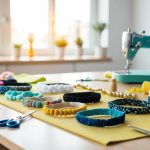How to Tailor Your Clothes at Home for a Perfect Fit: Expert Tips and Techniques
Altering Pants and Skirts
For pants, hemming the bottom is often necessary, especially for shorter individuals. Measure the inseam to determine the appropriate length and fold the excess fabric inside before stitching. Using hem tape can secure the hem if we prefer not to sew. Adjusting the waistline involves either taking in or letting out the sides. We need to open the side seams, adjust the fabric, and resew for a seamless appearance.
Skirts can be lengthened or shortened similarly by hemming. Adding or removing pleats can change the skirt’s fullness and fit, while adjusting the waistband ensures comfort and style. Taking in side seams on skirts, like pants, can improve fit dramatically. For both garments, always iron thoroughly after alterations to set the stitches and smooth out the fabric for a polished look.
We can easily transform our shirts, blouses, pants, and skirts into perfectly fitting pieces by mastering these techniques.
Finishing Touches
We need to give extra attention to details to achieve a polished and professional look in our tailored clothes. This includes adding embellishments and ensuring clean seams and hems. These steps are crucial in not just improving the fit but also enhancing the appearance.
Adding Embellishments
Embellishments can transform ordinary garments into unique pieces that showcase our personal style. Some popular options include embroidery, beads, sequins, and patches. We need to carefully choose embellishments that match the fabric type and garment style to maintain a cohesive look.
It’s essential to secure embellishments properly to the fabric. For embroidery, using a hoop can help keep the fabric taut. Beads and sequins should be sewn on with sturdy thread to prevent them from falling off. Patches can be ironed on or hand-stitched for a more secure attachment.
In planning our design, it’s helpful to sketch out where the embellishments will go before starting. This ensures we achieve a balanced and aesthetically pleasing result. Remember to consider the garment’s wearability and how the embellishments might affect its comfort and care.
Ensuring Clean Seams and Hems
Clean seams and hems are fundamental to a professional-looking finished garment. Seams should be consistent and lie flat without puckering. Pressing the seams as we sew can help maintain their neatness.
For hems, it’s important to keep them even and secure. Techniques such as blind hemming are useful for a clean finish without visible stitches. If replicating the original hem, make sure to match the stitching pattern and thread color.
We should also trim excess fabric from the seams and hems to reduce bulk. Investing in quality tools like sharp scissors and a good pressing iron can make a significant difference in achieving crisp results. Double-checking our work ensures that sewn edges are straight and smooth.
By focusing on these details, we can elevate our altered garments, making them look professionally tailored and fit seamlessly into our wardrobe.
Advanced Tailoring Techniques
Mastering advanced tailoring techniques helps us achieve a perfect fit and allows us to work with a variety of complex fabrics and create custom patterns with precision.
Handling Complex Fabrics
When handling complex fabrics, the right tools and methods make a significant difference. For instance, delicate fabrics like silk require sharp needles and fine thread to avoid damage. We must also use a proper lining to add structure without compromising the fabric’s natural drape.
For stretchy fabrics such as jersey, a walking foot and ballpoint needles are essential. These tools help prevent the fabric from stretching out of shape. It’s also crucial to stabilize seams with stay tape to maintain their integrity.
Thicker fabrics like wool demand a heavier duty sewing machine and thicker needles. Ironing becomes vital for pressing seams open, providing a crisp finish. We must also use tailor’s chalk to mark cuts and darts accurately, ensuring precision.



